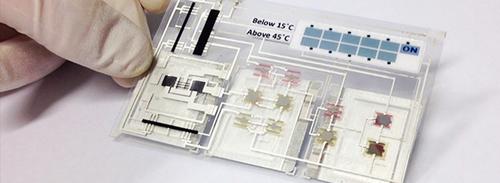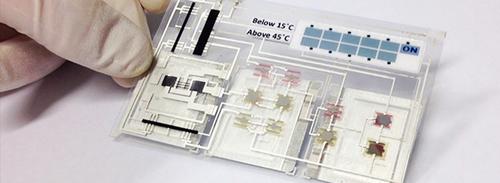Thinfilm Offers Printed-Electronics Standalone Sensor System
October 30, 2013

A Norwegian company claims it's built the first standalone smart-label sensor from printed electronics, a battery-driven system that can be used to provide temperature management for perishable goods.
Thinfilm Electronics, based in Oslo, will begin offering next year a low-power smart temperature-tracking label that uses a built-in sensor that can be used to gauge whether goods like meat, fish, or vegetables have been kept at the appropriate temperature as they travel from supplier to stores, Heidi Arnesen, communications manager for Thinfilm, told Design News in an interview.
Printed electronics are those that use polymers and other materials rather than silicon, and are printed through a variety of methods -- such as rotogravure or slot-die coating, making them more cost effective than silicon products, she told us.

Thinfilm, founded in the mid-1990s as a subsidiary of Opticom, already offers a number of electronically printed products, including printed rewriteable memory and a brand-protection system that can be placed on goods and can be scanned to ensure the goods are authentic.
The new smart label is an extension of its product line and one in what will be a number of smart labels that can provide different functions at a low cost to comparative, silicon-based technology, Arnesen said. "A silicon tag on a crate of melons costs 14 or 11 dollars," she said. "We are aiming for a cost of between 30 cents to 50 cents a tag."
The label itself is about the size of a credit card with a display that communicates with a temperature sensor through transistors. The sensor uses embedded logic to determine whether a set temperature threshold has been exceeded, then sends that information to the display, which will light up with an alert that someone in the supply chain can read and remedy the situation, Arnesen said.
Thinfilm worked with a number of partners for components of the smart label. While the company itself provided the memory, PARC, a Xerox Company based in California, provided the logic, Arnesen said. Other companies -- Acreo in Sweden and PST Sensors in South Africa -- provided the display and sensor technology, respectively.
Smart labels like Thinfilm's can be enabling technology for the Internet of Things, in which everyday items have intelligence through technology that allows them to communicate with each other and devices, Arnesen said. "By making the items in the world a little bit smarter, we're one step closer to enabling the Internet of everything," she told us.
The next step for the smart labels is to support wireless protocols so they can be read remotely and interact with other wireless devices, Arnesen added. Thinfilm expects the labels to be available in 2014.
Related posts:
About the Author(s)
You May Also Like

.jpg?width=300&auto=webp&quality=80&disable=upscale)

